
 |
Tea Clipper |
 |
| from TeaAntiques.com | ||
| Edition Fifty Seven |
A charming large Creamware jug (or Pitcher) decorated with delightful printed scenes in black of 'The Farmer's Arms' on one side and 'God Speed The Plough' on the reverse. It is also embellished on the front face with a circular print of a young swain in a rural scene with a hay stack in the background. This type of jug, with its barrel shape was probably made in Liverpool. It dates from c1790-1800.
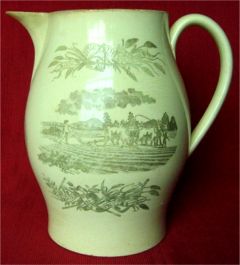
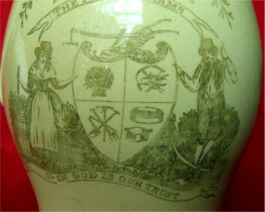
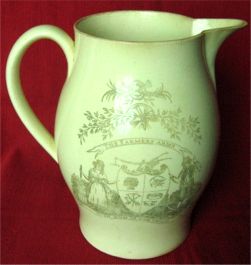
The main print shows a farmer and his wife as supporters to the farmer's coat of arms in a shield. There is a banner above the shield in which is written 'The Farmers Arms'. Above this motto is a wreath of foliage with crossed horns and a collection of farming tools from which emanates foliage on each side. The collection of tools include a spade, rack and pitch fork.
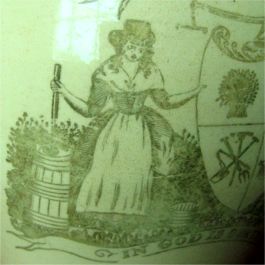
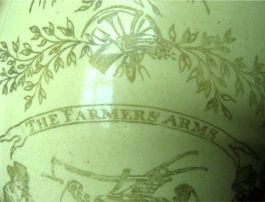
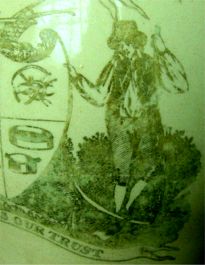
The scene on the reverse of the jug shows a farmer ploughing a field with a plough pulled by four oxen. The Oxen are led by the farmer's boy from the front. The motto above this scene is 'God Speed The Plough'.
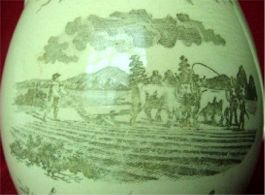
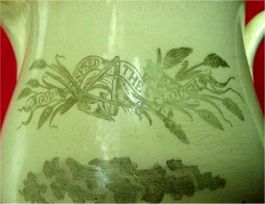
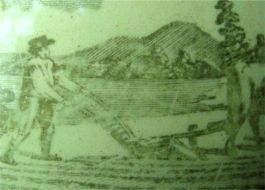
This most charming jug may well have been used by a Farmer and his family to celebrate a harvest or the sowing of the crops in Spring and may have contained something such as Cider or beer.
More details of this item and other tea related antiques can be found by visiting my web site at www.TeaAntiques.com.
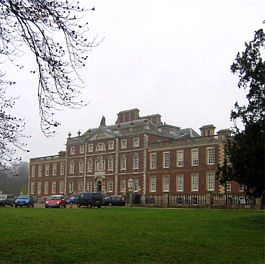 Ancestral home to the Earls of Hardwicke, Wimpole Hall is a very fine country
house near Cambridge in the East of England. Although the house has a much
earlier history, the house that we see today is largely the creation of the
Earls of Hardwicke. It was created from an earlier house dating from the 1650's,
the work of the gentleman architect, Sir Roger Pratt. This early house was in
the typical style of the seventeenth century and is now the core of the present
houses central block, with its seven bays.
Ancestral home to the Earls of Hardwicke, Wimpole Hall is a very fine country
house near Cambridge in the East of England. Although the house has a much
earlier history, the house that we see today is largely the creation of the
Earls of Hardwicke. It was created from an earlier house dating from the 1650's,
the work of the gentleman architect, Sir Roger Pratt. This early house was in
the typical style of the seventeenth century and is now the core of the present
houses central block, with its seven bays.
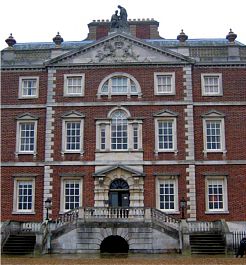 The house was improved in 1742, when it was refaced by Henry Flitscroft.
Philip, The First Earl of Hardwicke, Lord Chancellor, bought Wimpole Hall in
1740 from Lord Harvey. It was he who had the improvements made to the exterior
and interior of the house to its appearance we see today. Architect Flitscroft,
brought about a harmony to the house exterior, from what had become a mix of
styles through the seventeenth century. He faced the house with fine red brick
with Portland stone dressings and included the arms of Baron Hardwicke (as he
was at the time), in the pediment of the main central block of the house. The
main decorative feature of the South front of the house is the Venetian window
above the entrance, with a Diocletian (semi-circular) window above that.
The house was improved in 1742, when it was refaced by Henry Flitscroft.
Philip, The First Earl of Hardwicke, Lord Chancellor, bought Wimpole Hall in
1740 from Lord Harvey. It was he who had the improvements made to the exterior
and interior of the house to its appearance we see today. Architect Flitscroft,
brought about a harmony to the house exterior, from what had become a mix of
styles through the seventeenth century. He faced the house with fine red brick
with Portland stone dressings and included the arms of Baron Hardwicke (as he
was at the time), in the pediment of the main central block of the house. The
main decorative feature of the South front of the house is the Venetian window
above the entrance, with a Diocletian (semi-circular) window above that.
Entering the house through the door in the main block of the South front of the house takes the visitor into the Entrance Hall. The floor of the hall is decorated with colourful tiles in Geometric designs, that were the work of the Benthall Works of Maw and Company, Shropshire, c1880. To the left of the Hall is the Ante Room, this was used in the twentieth century as a Drawing Room by the then owner, Mrs Bambridge.
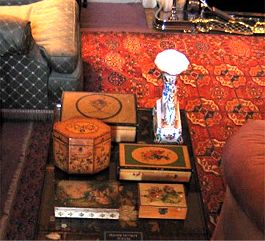 In the Ante Room, there are fine neo-Palladian door cases. Also surviving is
the original wall panelling that had been installed under the re-fitting by
Filtscroft in the 1740's. It is a nicely proportioned room with a comfortable
look to it, having cosy arm chairs grouped around the eighteenth century
fireplace. Also, in this room are a couple of extremely fine tea caddies, one
from the early nineteenth century with a domed lid. The finest of the two tea
caddies is one that is a single hexagon shape c1780, beautifully inlaid with
marquetry in the form of swags and flowers. The marquetry is coloured with green
as well as the natural colours of the exquisite wood veneers. Another fine and
interesting piece of furniture in this room is a Trome l'oeil painted Rosewood
writing table top, by L. Boilly. The top of this table is cleverly painted with
many objects including gaming cards, coins, pens and book. There are two
cabinets in the room which contain some beautiful porcelain figures, some
English and others Continental.
In the Ante Room, there are fine neo-Palladian door cases. Also surviving is
the original wall panelling that had been installed under the re-fitting by
Filtscroft in the 1740's. It is a nicely proportioned room with a comfortable
look to it, having cosy arm chairs grouped around the eighteenth century
fireplace. Also, in this room are a couple of extremely fine tea caddies, one
from the early nineteenth century with a domed lid. The finest of the two tea
caddies is one that is a single hexagon shape c1780, beautifully inlaid with
marquetry in the form of swags and flowers. The marquetry is coloured with green
as well as the natural colours of the exquisite wood veneers. Another fine and
interesting piece of furniture in this room is a Trome l'oeil painted Rosewood
writing table top, by L. Boilly. The top of this table is cleverly painted with
many objects including gaming cards, coins, pens and book. There are two
cabinets in the room which contain some beautiful porcelain figures, some
English and others Continental.
The next room along the South Front is the South Drawing Room. There is a fine plaster ceiling in eighteenth century style, but is a later copy put up in the 1840's. The room is painted in soft tones of a cream and pink, with similar colours used on the upholstery of the furniture. Like the Ante Room, this room has some soft padded arm chairs and also a settee. There is also some French furniture, including three eighteenth century open armchairs with Cabriole legs and two Austrian display cabinets. A fine tapestry French Aubusson carpet from the nineteenth century graces the floor, carrying the same soft colour tones of the room's decoration. A delightful pair of gilt framed mirrors between the windows, supported by gilt pier tables, beautifully reflect the elegance of the room.
The next room is the Gallery, a room that runs the full width of the house's West side. Originally this had been three smaller separate rooms, but was opened out into one room under the Flitscroft alterations. This alteration gave the room its function as a larger picture gallery and houses many family portraits of the Hardwicke family.
Beyond the Gallery is an interesting room, the Book Room, which includes some alterations made by the architect, Sir John Soane. These alterations are recognisable as the work of Soane's by the curving arches and niches, which Soane's often used. This created a charming room in which the Earl of Hardwicke could house his growing collection of books. The shelves are still lined with this magnificent collection of leather bound books.
Off to the right of the Book Room is a magnificent and large room, The Library. This room is almost a full double cube in size and very masculine in the room's appearance and decoration. It had been created by the architect Gibb in the 1730's to house a huge collection of Lord Harvey's books which numbered over 50,000. The room was altered in the 1750's when the fireplace was moved from the far end to the centre of one side and three of the original windows were blocked up. There is an oak pulpit on casters in the room, which acted as library steps, allowing access to the books high up on the book shelves. A pair of globes on stands flank the far end of the room, one globe terrestrial, the other celestial, by William Cary and dating from the early nineteenth century.
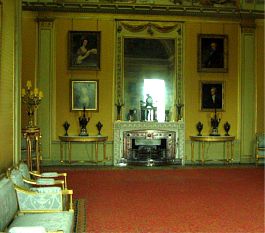 Retracing your steps through the Book Room and across the North end of The
Gallery, the visitor proceeds along the rooms on the north front of the house.
Firstly, there is the Red Room. In later years up to 1939, this room was used as
the family dining room. It is now used as a display room for various artefacts
and items of interest relating to the house. Beyond this room is the Yellow
Drawing Room. This is not only the grandest of the rooms in the house, it is
also the most unusual shape of them, being designed as a 'T' shape. It was
the creation of Sir John Soane in 1793, for the 3rd Earl of Hardwicke. It
was intended to house some of the Earl's picture collection and to also act as a
grand reception room in which he could host parties and balls. To the South end
of the room, Soane created a double height room, with dome and sky light. This
alteration meant the loss of several smaller rooms on the ground and first
floor, but the result is amazing. The ceiling is decorated and painted fine
plasterwork with panels painted with cherubs at play. On the South end of the
room there is a beautiful white marble fireplace, flanked by two gilt wood
tables above which hang four portraits.
Retracing your steps through the Book Room and across the North end of The
Gallery, the visitor proceeds along the rooms on the north front of the house.
Firstly, there is the Red Room. In later years up to 1939, this room was used as
the family dining room. It is now used as a display room for various artefacts
and items of interest relating to the house. Beyond this room is the Yellow
Drawing Room. This is not only the grandest of the rooms in the house, it is
also the most unusual shape of them, being designed as a 'T' shape. It was
the creation of Sir John Soane in 1793, for the 3rd Earl of Hardwicke. It
was intended to house some of the Earl's picture collection and to also act as a
grand reception room in which he could host parties and balls. To the South end
of the room, Soane created a double height room, with dome and sky light. This
alteration meant the loss of several smaller rooms on the ground and first
floor, but the result is amazing. The ceiling is decorated and painted fine
plasterwork with panels painted with cherubs at play. On the South end of the
room there is a beautiful white marble fireplace, flanked by two gilt wood
tables above which hang four portraits.
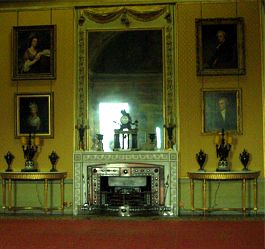 Above the fireplace is a huge gilt framed mirror and on the fireplace mantle
stands a French bronze and marble clock with a fourteen day striking movement by
Gavelle, c1790. The red carpet in the room is Axminster and the walls of the
room are hung round with a fine yellow silk. A very fine set of gilt framed
saloon furniture is arranged around the walls of the room, c1793. On the North
wall of the room, between the two windows is a mirror that has gilded wooden
balustrades to the lower portion which continues the line of the stone
balustrades outside of the windows when looking out over the gardens.
Above the fireplace is a huge gilt framed mirror and on the fireplace mantle
stands a French bronze and marble clock with a fourteen day striking movement by
Gavelle, c1790. The red carpet in the room is Axminster and the walls of the
room are hung round with a fine yellow silk. A very fine set of gilt framed
saloon furniture is arranged around the walls of the room, c1793. On the North
wall of the room, between the two windows is a mirror that has gilded wooden
balustrades to the lower portion which continues the line of the stone
balustrades outside of the windows when looking out over the gardens.
The next room is the Saloon, which is in the centre portion of the North Front and backs onto the Entrance Hall. In this room are a set of George II style open arm chairs, with the characteristic hair paw feet, typical of the George II period.
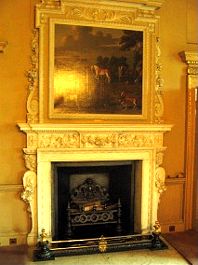
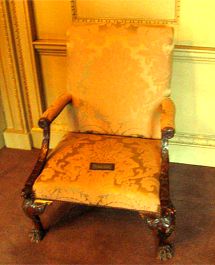
From the Inner Hall, a very elaborately decorated grand staircase leads up to the first floor bedrooms and dressing rooms.
Finally, in the basement, is a warren of servant rooms and in gaining access to these the visitor passes by an unusual Bath House. This Bath House was designed by Soane and includes a very large and deep tiled bath that held 2,199 gallons of water. This bath was heated from underneath by a large boiler, a fire place is positioned in the room for additional warmth, but to me it still looked a very cold place in which to bath!
In the Dry Store, accessible only from the Housekeeper's Room, look out for the large tin tea chests, marked Lapsang and the like. These are very large tea chests which go to show just how popular and widely drank tea was in this fine house.
Exiting the house and walking round to the South Side, there is the large and very beautifully laid out, Dutch Garden. This has the typical form of geometric beds, lined with box hedging creating the perfect foil to the eighteenth century house.
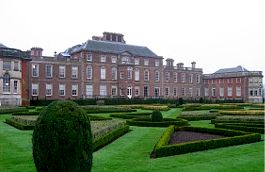
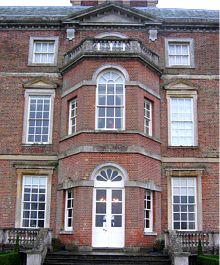
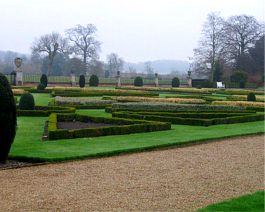
Situated next the church, which is also adjacent to the house, is the Old rectory, now a restaurant and one in which I can recommend that you partake in afternoon tea.
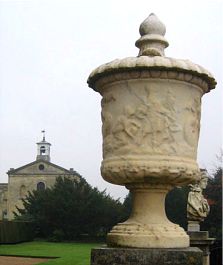
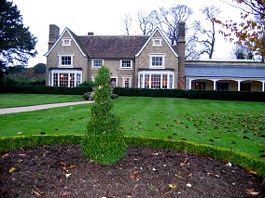
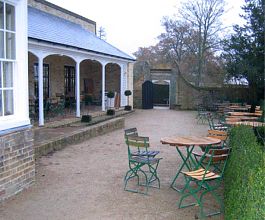
The Old Rectory is a stuccoed building in which are several rooms in which to take tea, but there is also a terrace on the North side which allows to to be enjoyed outside, weather permitting.
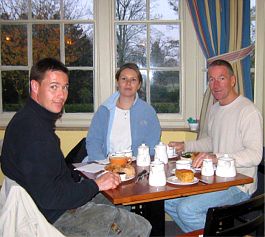
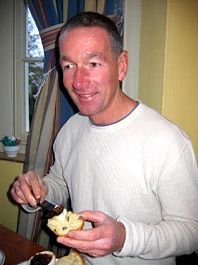
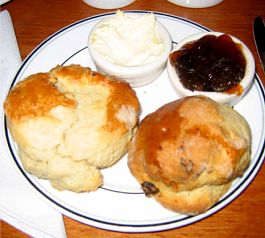
With friends, I partook of their afternoon tea with two large fruit scones, that were beautifully fresh and obviously home made. Also, the jam that accompanied the scones was also home-made locally and was this day a fruit packed, tangy plum jam. There was the usual cream, which was a good quality clotted cream, thick and rich. So often, the jam served with teas is of inferior quality, but this could certainly not be said of this plum jam.
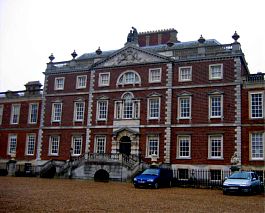
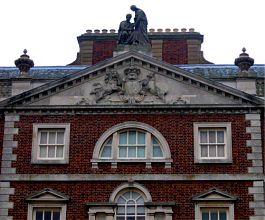
Click here for
Local Map
Map courtesy of www.streetmap.co.uk
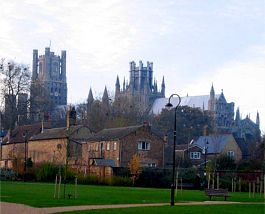
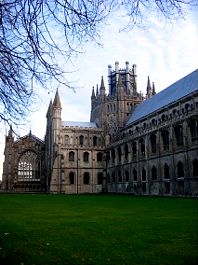 To the North East of Cambridge lies the small town of Ely. The town is sited
on high ground, in what is otherwise a very flat part of the country, these
flats known as the Fens. The town is dominated by the historic Cathedral, which
can be seen from miles around. Swinging around one side of the town is the River
Great Ouse. It is down by the banks of the Great Ouse, that I discovered a
really wonderful tearoom - Peacocks.
To the North East of Cambridge lies the small town of Ely. The town is sited
on high ground, in what is otherwise a very flat part of the country, these
flats known as the Fens. The town is dominated by the historic Cathedral, which
can be seen from miles around. Swinging around one side of the town is the River
Great Ouse. It is down by the banks of the Great Ouse, that I discovered a
really wonderful tearoom - Peacocks.
The tearoom being on the bank of the river, affords views of the river boats and barges that travel up and down the river. The house in which the tearoom is situated is a charming white brick period home, with Wisteria growing up over the front wall.
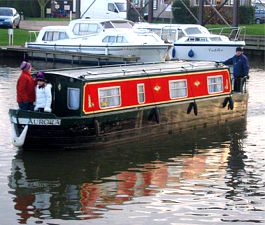
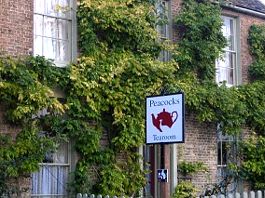
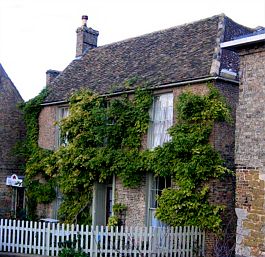
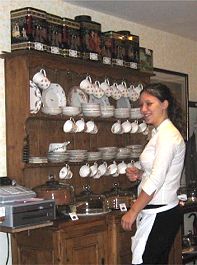 Inside there is a warm welcome from the manager and the sight of the old
fashioned dresser on which is set some delicious looking cakes, warms the heart.
Inside there is a warm welcome from the manager and the sight of the old
fashioned dresser on which is set some delicious looking cakes, warms the heart.
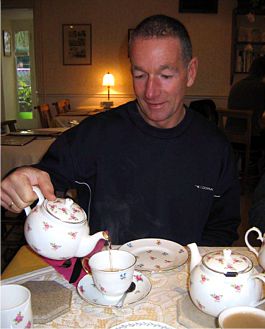 This very traditional tearoom, has tables laid with table clothes and serves
its teas on very beautiful floral decorated fine china. There is a whole page of
different teas to choose from, which was very impressive. It contained some
rather unusual blends and types of teas. Some of the teas listed included
English teas; flavoured black teas; green teas; oolongs; continental teas;
French favourites and further specialist teas.
This very traditional tearoom, has tables laid with table clothes and serves
its teas on very beautiful floral decorated fine china. There is a whole page of
different teas to choose from, which was very impressive. It contained some
rather unusual blends and types of teas. Some of the teas listed included
English teas; flavoured black teas; green teas; oolongs; continental teas;
French favourites and further specialist teas.
For my afternoon tea, I selected a blend of tea that hither too I had not had the pleasure of trying - sweet orange tea. I was to discover this to be a most enjoyable tea. It is a black tea, strongly flavoured with sweet orange peel.
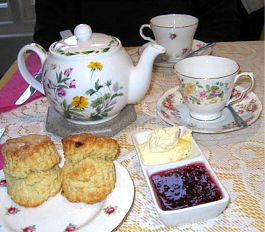
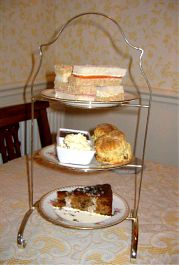
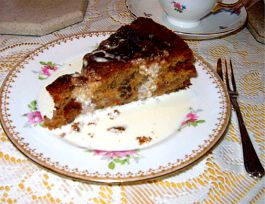
To accompany the tea, I indulged in a full afternoon tea. This comprised a selection of finger sandwiches, each made with brown and white bread, making them visually attractive. On the second tier of the silver cake stand were the usual scones with clotted cream and raspberry jam. The scones were excellent, fresh and home-made. Finally, I selected for my choice of cake, an apple and walnut cake. This was beautifully light textured and served with pouring cream.
I thoroughly enjoyed the tea at Peacocks and would highly recommend a visit. Some of the more unusual teas that you may wish to try were teas named river of clouds; dragon whiskers silver tip and monkey picked Ti Kuan Ying. The choice is yours!
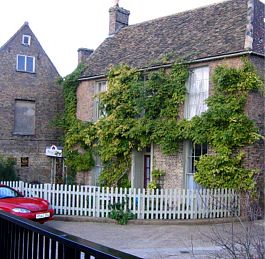
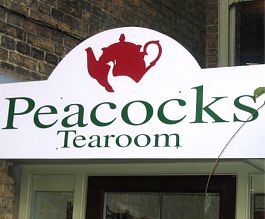
Peacocks Tearoom
65 Waterside
Ely
Cambridgeshire, CB7 4AU
Tel: 01353 661100
Click here for
Local Map
Map courtesy of www.streetmap.co.uk
To review past newsletters, just follow this link:
Past newsletters.
To subscribe to this free newsletter -
Click here